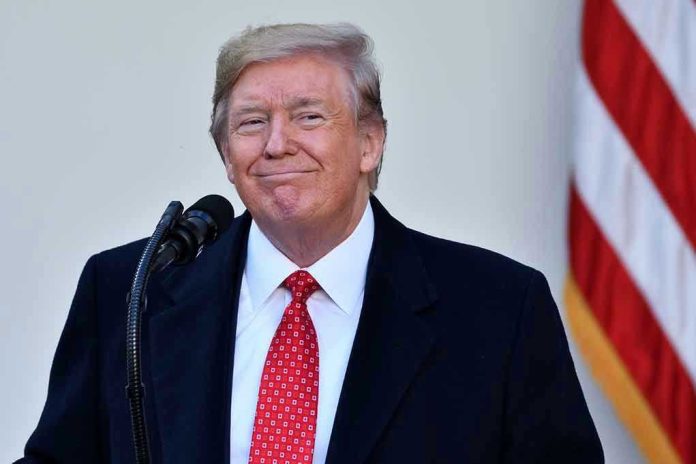
Trump’s $2,000 tariff check promise has ignited a fierce debate: can campaign theatrics actually deliver direct cash to Americans—or is this just the boldest bait-and-switch of the decade?
Story Snapshot
- Trump and his allies are touting $2,000 “tariff dividend” checks for Americans, funded by tariffs on imports.
- Checks could arrive in mid-2026, but only if Congress approves a plan facing major legal and fiscal hurdles.
- Economists warn the math doesn’t add up, with potential shortfalls and inflation risks looming.
- The proposal is shaping campaign rhetoric and could redefine the politics of trade, stimulus, and populism.
Trump’s $2,000 Tariff Check Gambit: Promise or Political Theater?
Donald Trump’s declaration that Americans could see $2,000 “tariff dividend” checks by mid-2026 has electrified his base and puzzled economists. The plan, pitched as a direct benefit from tariffs on imported goods, is unlike any previous stimulus: rather than tapping general federal funds, Trump claims the money will come straight from new import taxes. Supporters see it as a clever campaign move aligning with his “America First” mantra. Critics argue it’s a fiscal fantasy that’ll never survive scrutiny or the legislative gauntlet.
Trump’s allies in Congress have enthusiastically echoed the plan, urging colleagues to rally behind the proposal. Early November 2025 saw the first public push, with Trump reiterating his timeline—mid-2026 for the first payments—just days later. The pitch is simple: tariffs punish foreign countries and reward American families. But turning that slogan into policy requires congressional approval, a feat that’s anything but simple in the current polarized environment.
The Unprecedented Mechanics of Tariff-Funded Stimulus
No modern U.S. administration has ever proposed using tariff revenue for universal direct payments. Previous tariffs, notably during Trump’s first term, were used to support select industries like agriculture hit by the trade war. The COVID-19 era stimulus checks, while popular, drew from the federal purse, not import taxes. Trump’s plan rewrites that playbook, promising a “dividend” for low- and middle-income Americans directly tied to tariff haul. This innovation alone ensures the proposal will remain a lightning rod for legal and economic debate.
The plan’s fate depends on Congress, which must authorize both the tariffs and the spending. Trump’s sway over the GOP base puts pressure on lawmakers, but fiscal hawks and Democratic opposition remain formidable obstacles. As of mid-November 2025, the proposal hasn’t advanced to formal legislation. The White House has floated alternate forms of relief—possibly tax cuts—but nothing is promised before 2026. Voters remain tantalized but in limbo, waiting to see if campaign rhetoric ever morphs into real checks.
Economic Realities: Math, Inflation, and the National Debt
Experts have lined up to challenge the feasibility of the $2,000 checks. John Ricco of Yale’s Budget Lab estimates the plan could cost around $600 billion, while projected tariff revenue would fall $300–400 billion short. Erica York from the Tax Foundation bluntly summarizes the consensus: “The numbers just don’t check out.” Skeptics warn that funding direct payments with tariffs could stoke inflation, especially since tariffs often raise consumer prices, hitting the very households the checks aim to help.
Legal barriers add another layer of complexity. While the executive branch can propose tariffs, only Congress can allocate the resulting revenue. With the national debt topping $37 trillion and inflation already high, lawmakers face tough questions about whether such a plan is fiscally responsible—or even constitutional. Trump’s allies point to the political payoff of direct cash, but experts warn the precedent could send budget discipline out the window, with future administrations tempted to repeat the maneuver.
Winners, Losers, and the 2026 Political Chessboard
Low- and middle-income Americans are the promised winners, but every consumer could lose if tariffs spark price hikes. Retailers and manufacturers dependent on imports brace for higher costs, while the agricultural sector—previously the main beneficiary of tariff revenue—wonders if their bailouts will dry up. Politically, the proposal could reshape the 2026 midterms, energizing Trump’s base while giving opponents fresh ammunition about fiscal recklessness and empty promises.
Divided public opinion reflects the broader anxiety over the U.S. economy. Some see the plan as overdue relief; others view it as a gimmick. Nonpartisan think tanks and budget analysts remain broadly skeptical, while media coverage amplifies both enthusiasm and doubt. Whether the checks ever materialize or not, Trump’s $2,000 tariff promise has already altered the terrain of American economic debate—forcing voters, lawmakers, and experts to confront what “America First” means in practice when the math is this contentious.







